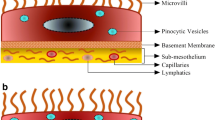Summary
It was the aim of this investigation to find out why pentetrazol (PTZ) administered orally to rats has considerably lower convulsive effectiveness than PTZ injected parenterally.
It could be demonstrated that PTZ is distributed to and eliminated from all organs analyzed, without any sign of storage or of redistribution. Biological halftime was found to be about 3.5 h after subcutaneous injection.
PTZ is absorbed slowly from the gastrointestinal tract because PTZ given orally is retained in the stomach for many hours. PTZ absorption is slow from the stomach while it is rapid from the small intestine.
Food taken in before and after PTZ administration decreases the rate of PTZ absorption.
Retention in the stomach of PTZ given orally is probably due to delayed gastric emptying since PTZ is able to reduce the basal tone and the acetylcholine-induced contractions of isolated preparations of the fundus of the stomach.
Similar content being viewed by others
Abbreviations
- PTZ:
-
for pentamethylenetetrazol
References
Ananth, J. W., Deutsch, M., Ban, T. A.: Senilex in the treatment of geriatric patients. Curr. ther. Res. 13, 316–321 (1971)
Baur, M.: Versuche am Amnion von Huhn und Gans. Naunyn-Schmiedebergs Arch. exp. Path. Pharmak. 134, 49–65 (1928)
Brodie, D. A.: A comparison of anticholinergic drugs on gastric secretion, gastric emptying, and pupil diameter in the rat. Gastroenterology 50, 44–50 (1966)
Drill's Pharmacology in Medicine (J. R. Di Palma, ed.) 3rd ed., p. 388. New York: Mc Graw Hill 1965
Ebert, W. R., Morris, R. W., Rowles, S. G., Russell, H. T., Born, G. S., Christian, J. E.: In vivo evaluation of absorption and excretion of pentylenetetrazol-10-14C from sustained-release and nonsustained-release tablets. J. Pharmaceut. Sci. 59, 1409–1412 (1970)
Esplin, D. W., Woodbury, D. M.: The fate and excretion of C14-labeled pentylene-tetrazol in the rat, with comments on analytical methods for pentylenetetrazol. J. Pharmacol. exp. Ther. 118, 129–138 (1956)
Ferguson, H. C.: Dilution of dose and acute oral toxicity. Toxicol. appl. Pharmacol. 4, 759–762 (1962)
Goldstein, A., Aronow, L., Kalman, S. M.: Principles of drug action: The basis of pharmacology; Harper and Row, Publishers, Incorp.; Hoeber Medical Division 1968, p. 120
Hahn, F.: Analeptics. Pharmacol. Rev. 12, 447–530 (1960)
Hildebrandt, F.: Pentamethylenetetrazol (Cardiazol) I. Mitteilung. Naunyn-Schmiedebergs Arch. exp. Path. Pharmak. 116, 100–109 (1926)
Hildebrandt, F.: Pentamethylentetrazol (Cardiazol®). Handbuch Exper. Pharmacologie, Ergänzungswerk Bd. 5, S. 151–183. Berlin: Springer 1937
Hoffmann, H.: Biologische Normalwerte bei Wistarratten (Jena) verschiedenen Alters, VI. Mitteilung: Magenentleerungszeit, Dünndarmpassagezeit und Längenentwicklung des Dünndarms. Z. Versuchstierk. 12, 347–355 (1970)
Ko, G. K., Hosein, E. A.: The metabolic fate of pentylenetetrazol in the rat. Canad. J. Physiol. Pharmacol. 49, 356–365 (1971)
Krondl, A.: Present understanding of the interaction of drugs and food during absorption. Canad. med. Ass. J. 103, 360–364 (1970)
Leckman, J., Ananth, J. V., Ban, T. A., Lehmann, H. E.: Pentylenetetrazol in the treatment of geriatric patients with disturbed memory function. J. clin. Pharmacol. 11, 301–303 (1971)
Mautner, H., Yetwin, I. J.: The effect of pentamethylenetetrazol (Metrazol) on the stomach. J. Amer. pharm. Ass. 32, 17–20 (1943)
McGilveray, I. J., Mattok, G. L.: Some factors affecting the absorption of paracetamol. J. Pharm. Pharmacol. 24, 615–619 (1972)
Prescott, L. F.: Gastrointestinal absorption of drugs; symposium on individualization of drug therapy. Med. clin. N. Amer. 58, 907–915 (1974)
Rowles, S. G., Born, G. S., Russell, H. T., Kessler, W. V., Christian, J. E.: Biological disposition of pentylenetetrazol-10-14C in rats and humans. J. pharm. Sci. 60, 725–727 (1971)
Siegel, P. S., Stuckey, H. L.: The diurnal course of water and food intake in the normal mature rat. J. comp. physiol. Psychol. 40, 365–370 (1947)
Stotsky, B. A., Cole, J. O., Sniffin, C. M.: A controlled study of the efficacy of pentylenetetrazol (Metrazol) with hard-core hospitalized psychogeriatric patients. Amer. J. Psychiat. 129, 387–391 (1972)
Tarttelin, M. F., Gorski, R. A.: Variations in food and water intake in the normal and acyclic rat. Physiol. Behav. 7, 847–852 (1971)
Ter Haar, M. B.: Circadian and estrual rhythms in food intake in the rat. Horm. Behav. 3, 213–219 (1972)
Vane, J. R.: A sensitive method for the assay of 5-hydroxytryptamine. Brit. J. Pharmacol. 12, 344–349 (1957)
Vohland, H. W., Koransky, W.: Effect of α-Hexachlorocyclohexane on metabolism and excretion of pentetrazol (Cardiazol®) in the rat. Naunyn-Schmiedeberg's Arch. Pharmacol. 273, 99–108 (1972)
Vohland, H. W., Koransky, W., Zufelde, H.: Effect of α-Hexachlorocyclohexane on the convulsive activity of pentetrazol (Cardiazol®) in the rat. Naunyn-Schmiedeberg's Arch. Pharmacol. 275, 289–298 (1972)
Vohland, H. W., Schulze, P. E., Koransky, W., Schulz, G., Acksteiner, B.: Stoffwechsel von Pentetrazol bei der Ratte. Hoppe-Seylers Z. physiol. Chem. 355, 1274–1280 (1974)
Withrow, C. D., Stout, R. J., Barton, L. J., Beacham, W. S., Woodbury, D. M.: Anticonvulsant effects of 5,5-dimethyl-2,4-oxazolidinedione (DMO). J. Pharmacol. exp. Ther. 161, 335–341 (1968)
Zucker, I.: Light-dark rhythms in rat eating and drinking behavior. Physiol. Behav. 6, 115–126 (1971)
Author information
Authors and Affiliations
Rights and permissions
About this article
Cite this article
Vohland, H.W., Zufelde, H. Factors responsible for reduced pharmacological activity in rats of pentetrazol administered orally. Naunyn-Schmiedeberg's Arch. Pharmacol. 293, 277–283 (1976). https://doi.org/10.1007/BF00507350
Received:
Accepted:
Issue Date:
DOI: https://doi.org/10.1007/BF00507350




